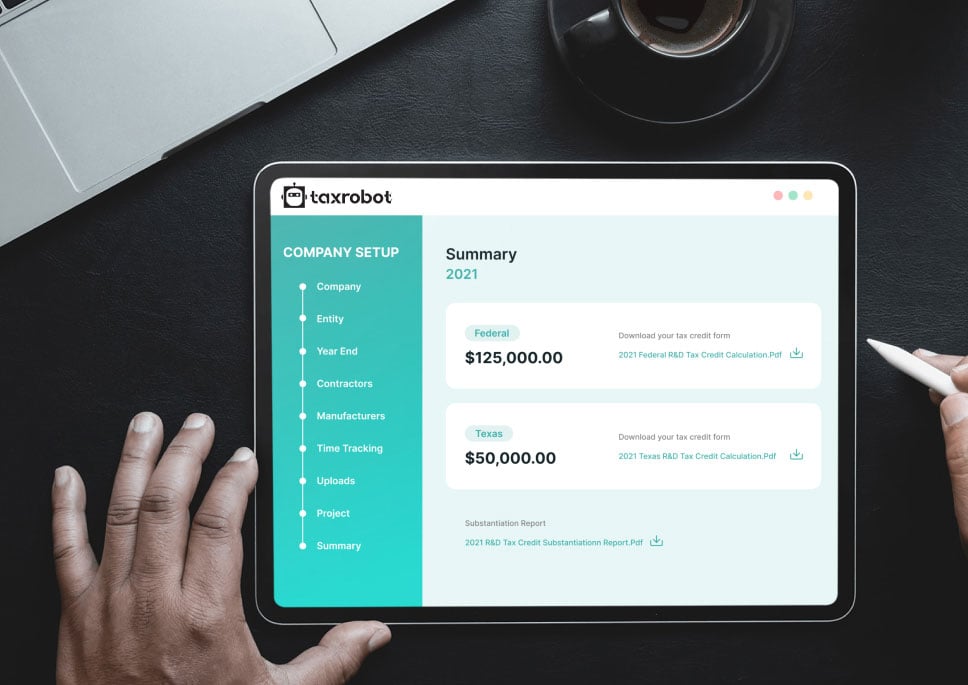Connecticut R&D Credit
Connecticut businesses have access to an incredible tax credit as long as they know where to look for it. Let TaxRobot make it easy.
Maximize your State Credits today!
Put the R&D tax credit process on autopilot.
Trusted By:








Connecticut R&D Credit
Discover your eligibility for Connecticut R&D tax credits and supercharge your enterprise.
Are There R&D Tax Credits for Connecticut?
Yes, there are R&D tax credits available for businesses in Connecticut. The R&D tax credit is an incredible program that allows businesses to save by investing in improving their products, services, processes, and more.
Right now, there are two tax credits in Connecticut, which already makes the tax credits in Connecticut more attractive than some other states. However, there is talk that the availability of certain credits will expand in the future. So, staying on top of tax credits is even more essential in Connecticut than elsewhere.
Both credits are based on R&D spending. Specifically, they are based on qualified expenses relating to this type of spending. For Connecticut, the definition of qualified expenses is the same as the federal definition, which is used to determine the federal R&D tax credit.
Incremental R&D Credit
The first of Connecticut’s tax credits is the Incremental R&D Credit. This credit is based on increases in R&D expenses. This is measured by the amount of R&D expenses in one year compared to the previous year. Specifically, the credit ends up being 20% of the increase in R&D expense. This applies only to qualified expenses from within the state of Connecticut.
This credit is designed to encourage companies to continue to invest in R&D. By offering up such a powerful incentive, it helps promote overall innovation within the state.
Another good thing about this credit is that it can be carried forward for 15 years. However, it cannot be carried backward. In addition, it is capped at 70% of the tax due starting in 2023.
Non-Incremental R&D Credit
Alongside the incremental R&D tax credit, Connecticut also offers a non-incremental R&D tax credit. This is focused on a single year’s R&D expenses rather than the increase in R&D spending versus the previous year.
Small businesses can use this tax credit to claim up to 6% of the year’s R&D expenses. Other companies determine their tax credit based on their expenses and a detailed table found on the Connecticut State Department of Revenue Services website. This is also capped at 70% of the tax due.
This is a great way for businesses to take advantage of this tax credit without having to have invested in R&D previously. This makes it easy for any company to start putting money into an investment like this and have it immediately start working for them.
Like the previous credit, this credit also carries forward. After 2021, all tax credits from this carry forward the same amount of time, 15 years.
Does Your Business Qualify?
This credit is only applicable to corporate income tax. This means your business must be a C-corporation filing a Form CT-1120. There is no flow through credit. This means S-corps do not qualify as they do not have any corporate tax liability.
In addition, your business must be a qualified small business. This means your gross income in the previous income year must be below $70 million for the Incremental R&D Credit or $100 million for the Non-Incremental R&D Credit. This makes the credit a great item to work into any business plan for a small business with big dreams.
Take Advantage of the Connecticut R&D Credit
The application for both the incremental and non-incremental credits is due with your Connecticut tax filing. This makes this one aspect of filing simple, as you only have one date to look out for.
However, the rest can be quite complicated. Despite this, filling out the necessary forms and applying for the credit correctly is important. That is why many people trust TaxRobot to make the process easier. Our AI-powered software provides numerous advantages when going about this process. We’ll help you maximize your credit while providing support should you ever get audited.
Find Out How Much You Could Save
Wondering how much you could save with the Connecticut R&D credit? Try our calculator to get an estimate.
Take a sneak peak

- Limited Time Offer
- Simple Onboarding
- Easy to Use
R&D Tax Credits FAQs
The four-part test as outlined in the Internal Revenue Code is used to determine qualified R&D activity.
The Four-Part Test
1). New Or Improved Business Component
Creation of a new product, process, formula, invention, software, or technique; or improving the performance, functionality, quality, or reliability of existing business component.
- Construction of new buildings or renovation of existing buildings
- Invention of a software application
- Manufacturing of a new product or the improvement of the production process for an existing product
- Creation of design documentation
2). Technological In Nature
The activity fundamentally relies on principles of the physical or biological sciences, engineering, or computer science. A taxpayer does not need to obtain information that exceeds, expands or refines the common knowledge of skilled professionals in a particular field.
- Physics (relationship between mass, density and volume; loading as the
result of gravitational attraction) - Engineering (mechanical, electrical, civil, chemical)
- Computer science (theory of computation and design of computational systems)
3). Elimination Of Uncertainty
Uncertainty exists if the information available to the taxpayer does not establish the capability or method for developing or improving the business component, or the appropriate design of the business component.
- The capability of a manufacturer to create a part within the specified tolerances
- The appropriate method of overcoming unsuitable soil conditions during construction
- The appropriate software design to meet quality and volatility requirements
4). Process Of Experimentation
A process designed to evaluate one or more alternatives to achieve a result where the capability or method of achieving that result, or the appropriate design of that result, is uncertain as of the beginning of the taxpayer’s research activities.
- Systematic process of trial and error
- Evaluating alternative means and methods
- Computer modeling or simulation Prototyping Testing
The R&D tax credit is one of the most misunderstood tax incentives available. Considering the myriad of industries and activities that legally qualify for the credit, the term “research and development” is a misnomer. Additionally, the R&D tax credit requires specialized knowledge and technology to identify and calculate the incentive properly.
Companies of various industries are unaware that they are eligible to claim the R&D tax credit. Under the Internal Revenue Code’s definition of R&D, many common activities qualify. You can get tax benefits for industries including software, technology, architecture, engineering, construction, manufacturing, and more.
The R&D tax credit can be claimed for all open tax years. Generally, open tax years include the prior three tax years due to the statute of limitations period. In certain circumstances, the law allows businesses to claim the R&D tax credit for an extended period of time. It is common for companies to amend previous tax years to claim this benefit and reduce the maximum amount of tax liability.
Partnerships and S corporations must file this form to claim the credit. The credit will flow from the Form 6765, to the Schedule K-1, to the Form 3800 on the individual’s tax return. For individuals receiving this credit that have ownership interest in a partnership or S corporation, Form 6765 is not required on the individual return.
Individuals claiming this credit can report the credit directly on Form 3800, General Business Credit if their only source for the credit is a partnership, S corporation, estate, or trust. Otherwise, Form 6765 must be filed with the individual’s tax return (e.g. sole proprietorship).
For tax years prior to 2016, the credit can be used to reduce the taxpayer’s regular tax liability down to the tentative minimum tax. The credit cannot be used to offset alternative minimum tax. Beginning in tax year 2016, eligible small businesses have expanded utilization for the credit. For these eligible small businesses, the regular tax liability can offset alternative minimum tax using the “25/25” rule.
What our customers have to say
I highly recommend TaxRobot to anyone considering an R&D Tax Credit software to complete their analysis.

We decided to switch to TaxRobot… Best decision we’ve ever made. More affordable, and less complicated.

I couldn’t believe how easy it was! In under an hour, we saved enough money to hire a new employee.
